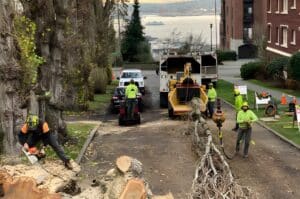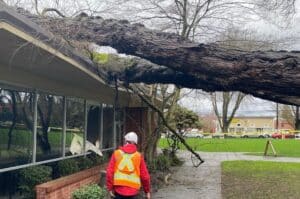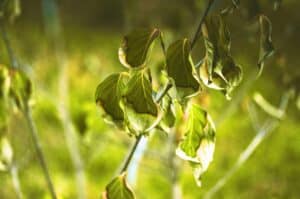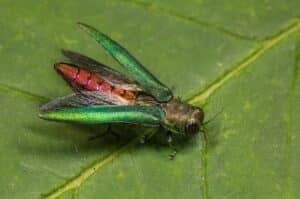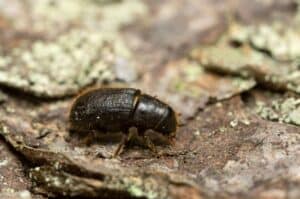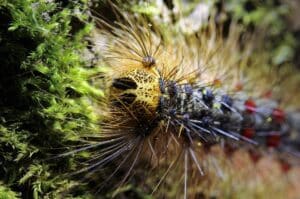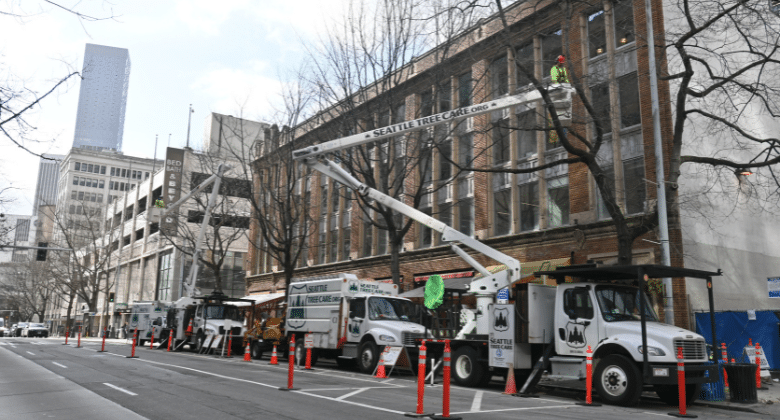5 Common Fungal Diseases Killing Seattle Trees
Discover five prevalent fungal tree diseases in Seattle, including a description of their symptoms, causes, transmission, treatment, and preventive measures.
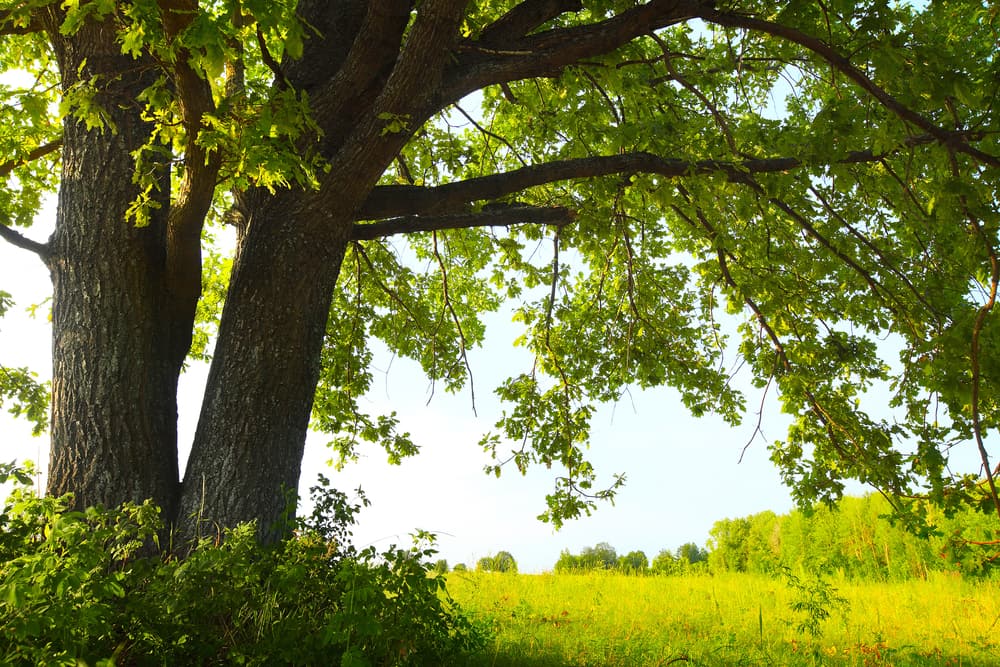
In the Seattle area, the health of our urban forest is under constant threat from fungal diseases, exacerbated by the city’s moist climate. These diseases not only mar the beauty of our landscapes but can also lead to the death of many trees if left unchecked. This article zeroes in on five prevalent fungal tree diseases in Seattle, offering insights into their symptoms, causes, transmission, and the trees they commonly affect.
Key Takeaways
- Seattle’s moist climate exacerbates the risk of fungal diseases, posing significant threats to the urban forest’s health and aesthetics.
- Five prevalent fungal diseases in Seattle require vigilant monitoring and informed management: Armillaria Root Disease, Laminated Root Rot, Dothistroma Needle Blight, Annosus Root Disease, and Swiss Needle Cast.
- Professional diagnosis and care from certified arborists, like those at Seattle Tree Care, are crucial for effectively treating and managing these diseases.
- Preventive measures, including planting disease-resistant species and ensuring proper tree spacing, are key to mitigating the risk of fungal infections.
- Regular monitoring and early detection of symptoms https://seattletreecare.org/sick-tree-signs/ can significantly help control the spread of fungal diseases and maintain the health of Seattle’s trees.
5 Most Common Fungal Tree Diseases in Seattle & Surrounding Areas
There are many fungal diseases that affect trees in the Pacific Northwest, such as Madrone Leaf Blight, Keithia Blight of western red cedar, Phytophthora root diseases, and new foliar diseases still being discovered. But there are five diseases caused by fungal pathogens that we see most often in the greater Seattle area. Those are the focus of this article.
#1 – Armillaria Root Disease (Shoestring Root Rot)
This particular fungal infection, also known as shoestring root rot, can show up in both living and dead trees. It usually starts by feeding off dead wood and then spreads to healthy trees, often attacking the root system where it’s difficult to detect. It can inhibit growth and eventually be deadly for the infected tree.
Signs and Symptoms
The most telling signs of Armillaria Root Disease include honey-colored mushrooms at the base of the tree, especially in the fall, and white mycelial mats (moldy-looking growth) under the bark. Trees may show signs of stress, such as dying branches, yellowing leaves, and reduced vigor, often becoming more evident as the disease progresses.
Causes and Transmission
This disease is caused by a family of fungi classified as Armillaria. There are several species within this classification, but the most common one is Armillaria mellea.
Armillaria spreads through direct contact between infected and healthy roots and through rhizomorphs—shoestring-like structures that allow the fungus to bridge gaps in the soil and infect new trees. The disease thrives in moist conditions, making Seattle’s climate particularly conducive to its spread.
Favored Trees
A wide range of trees are susceptible to Armillaria Root Disease, including both hardwoods and conifers. This broad host range poses a significant challenge for disease management within both landscaped environments and natural forests.
Treatment Options
Managing Armillaria Root Disease often involves removing infected trees to prevent further spread, a measure that requires a tree removal permit in Seattle. Improving soil drainage and avoiding wounding trees can also help reduce the risk of infection. In some cases, fungicides may be applied, but their effectiveness can vary and should be considered as part of a comprehensive management strategy.
Prevention
Prevention strategies include planting disease-resistant tree species, ensuring proper spacing between trees to reduce root contact, and maintaining healthy soil conditions. Regular monitoring and early detection are crucial for preventing widespread outbreaks.
#2 – Dothistroma Needle Blight
This fungal blight has caused havoc on Ponderosa pines throughout our region. It has caused infections mostly in adult trees and has been seen throughout the upper midwest and across California, Oregon, and Washington.
Signs and Symptoms
Infected needles first display dark green bands which later turn into reddish-brown spots or bands. As the disease progresses, the tree begins dropping needles starting from the lower branches upward. Eventually, the tree becomes completely defoliated and dies.
The most visible symptoms appear in late spring and early summer, coinciding with periods of moist weather that favor the fungus’s spread.
Causes and Transmission
A fungus called Dothistroma pini is the reason for this deadly tree disease. The fungus spreads through spores that are dispersed by wind and rain, infecting new needles during wet periods. The disease cycle is facilitated by prolonged leaf wetness, making it a recurring problem in Seattle’s climate.
Favored Trees
Dothistroma needle blight, as the name implies, attacks a wide variety of pines including the ponderosa pine and the Austrian pine. The disease’s preference for these species highlights the need for targeted management strategies in affected areas.
Treatment Options
Fungicide treatments can effectively manage Dothistroma Needle Blight, especially when applied early in the infection cycle. Pruning and removing severely affected branches or trees may also be necessary to reduce the source of spores. As always, tree removal in Seattle is regulated and may require a permit.
Prevention
Cultural practices such as improving air circulation around trees, avoiding overhead watering, and selecting resistant tree varieties can help prevent the disease. Regular monitoring and early detection are key to managing outbreaks effectively.
#3 – Laminated Root Rot
This is yet another fungus that is native to the Pacific Northwest and tends to infect trees in small clumps. It can easily spread from tree to tree and cause damage to a larger area.
Signs and Symptoms
The initial signs of Laminated Root Rot are often subtle, with yellowing or thinning foliage at the crown and a gradual decline in the tree’s overall health. As the disease progresses, symptoms become more pronounced, including reduced growth rate and the eventual collapse of the tree. Some trees, however, do not show signs of the disease until they fall over from rotting roots.
Causes and Transmission
This fungus that causes Laminated Root Rot (Phellinus weirii ) lives throughout the northwestern U.S. and parts of Canada. It has been detected as far as Japan.
The fungus spreads primarily through root-to-root contact, with the disease moving from infected to healthy trees. It can persist in dead roots and stumps, creating reservoirs of infection that can impact new plantings or neighboring trees.
Favored Trees
Douglas fir, white fir, and other species of conifers are particularly susceptible to Laminated Root Rot. The disease’s preference for these species poses a significant risk to Seattle’s conifer-dominated landscapes. It affects trees of all ages and sizes and can inhabit a wide variety of hosts. Hardwoods seem to be immune.
Treatment Options
Because this fungus can live in dead material and is passed by the root systems, sometimes the only solution for the health of the surrounding trees is to remove infected trees and stumps. Since tree removal in Seattle requires a permit, it’s important to consult with city regulations before proceeding.
Prevention
Preventive measures include avoiding the replanting of susceptible conifers in areas known to be infected with the disease. Implementing good sanitation practices, such as removing dead and dying trees and stumps, can help limit the fungus’s ability to spread.
#4 – Annosus Root Disease
This fungal disease may be called many names, including annosum root rot, annosus root rot, or Heterobasidion root rot. Regardless of what it’s called, it’s a deadly problem that stunts and topples conifers throughout our region.
Signs and Symptom
Symptoms of Annosus Root Disease include reduced growth, thinning of the canopy, and pale or discolored foliage. Infected trees may also show signs of root decay, making them susceptible to windthrow. Symptoms can be observed throughout the year but may become more noticeable as the disease progresses.
Causes and Transmission
In Washington state, this root disease is caused by two closely related fungi, Heterobasidion occidentale and Heterobasidion parviporum, both formerly known as Heterobasidion annosum. The fungus enters trees through wounds in the roots, spreading from infected stumps and roots to healthy trees via contact or through the soil. The disease is particularly prevalent in areas with a history of logging or where tree stumps have been left in the ground.
Favored Trees
Conifer species, particularly those native to the Pacific Northwest, are most at risk from Annosus Root Disease, including pine, fir, juniper, cypress, Douglas fir, sequoia, and hemlock. The disease’s impact on these trees can lead to significant losses in forested and landscaped settings.
Treatment Options
Managing Annosus Root Disease involves the removal of infected trees and stumps to prevent further spread. Chemical treatments may also be applied to protect healthy trees or to treat soil in affected areas. Compliance with Seattle’s tree removal permit requirements is essential when removing trees.
Prevention
Preventive measures include avoiding injury to tree roots, proper sanitation of logging equipment, and using resistant tree species in reforestation efforts. Maintaining healthy forest stands and monitoring.
#5 – Swiss Needle Cast
Swiss Needle Cast is a fungal tree disease that predominantly affects Douglas Fir trees, leading to premature needle loss, reduced photosynthesis, and diminished growth and vigor. This disease has become increasingly prevalent in Seattle, where Douglas Firs are a common and iconic part of the landscape.
Signs and Symptoms
The most apparent symptoms include the yellowing or browning of needles, followed by premature needle drop, usually affecting older needles first. This results in sparse foliage, thin crowns, and reduced growth rates. Symptoms are most noticeable in late spring and early summer but may vary with environmental conditions.
Causes and Transmission
The disease is caused by the fungus Phaeocryptopus gaeumannii, which thrives in the cool, wet climate of the Pacific Northwest. Spores are spread by wind and rain, infecting new needles during moist periods. The disease cycle is closely tied to specific weather conditions, making outbreaks more severe in certain years.
Favored Trees
Swiss Needle Cast primarily affects Douglas Fir trees, although other species may be susceptible to a lesser degree. The disease’s impact on Douglas Firs is of particular concern in Seattle and the surrounding region, where these trees play a vital ecological and aesthetic role.
Treatment Options
Management strategies for Swiss Needle Cast include improving air circulation and sunlight penetration within tree stands through thinning and pruning. Fungicide applications can offer some protection for high-value trees or in nursery settings but are generally not practical for large, forested areas. Removal may be necessary in cases where trees are severely affected and pose a safety risk, subject to Seattle’s tree removal permit process.
Prevention
Preventive measures focus on selecting resistant varieties of Douglas Fir for new plantings and ensuring adequate spacing between trees to reduce humidity and spore load. Monitoring tree health regularly can also aid in early detection, allowing for timely management interventions.
Frequently Asked Questions About Fungal Tree Diseases in Seattle
Q. What are the best disease-resistant trees to plant in Seattle to avoid fungal diseases?
A. Planting native species such as Western Red Cedar and Pacific Madrone, which are generally more resistant to local fungal diseases, is recommended.
Q. Can a tree recover from a fungal disease without intervention?
A. Some trees may naturally fight off mild infections, but most fungal diseases require professional intervention to prevent serious damage or death.
Q. What should I do with fallen leaves from a tree infected with a fungal disease?
A. Collect and dispose of them properly, preferably by bagging and removing them from the site to prevent the spread of disease.
Q. What is the cost of tree removal if it’s infected with a fungal disease in Seattle?
A. Costs can vary widely depending on the tree’s size, location, and the complexity of the removal. It’s best to get a quote from a certified arborist.
Q. How often should I have my trees inspected by an arborist in Seattle?
A. It’s advisable to have trees inspected at least once a year or whenever you notice any signs of disease or distress.
From Diagnosis to Treatment: Protecting Seattle From Fungal Tree Diseases
The lush landscapes we cherish in Seattle face threats from fungal diseases like Armillaria Root Disease, Laminated Root Rot, Dothistroma Needle Blight, Annosus Root Disease, and Swiss Needle Cast. These conditions compromise the health and beauty of our urban and natural forests and demand expert attention for effective management.
With its team of certified arborists, Seattle Tree Care, a registered tree care service provider, stands ready to diagnose and combat these diseases. Our approach combines advanced diagnostic methods with sustainable treatment solutions tailored to ensure the health and longevity of Seattle’s trees.
If your trees show signs of distress or you’re seeking preventive care, call our certified arborists at 206-789-0534. Together, we can maintain the health and beauty of Seattle’s trees, ensuring they continue to thrive for future generations.
SEE MORE ARTICLES FROM OUR b(LOG)
We've got you covered with tips, resources, updates, how-to's, and other helpful information about trees and landscapes in Seattle, Puget Sound, and King County, WA. Join the thousands of smart local residents who get the monthly newsletter from Seattle Tree Care for helpful information you won't want to miss!
There's no spam - we promise! We are committed to keeping your e-mail address confidential. We do not sell, rent, or lease our contact data or lists to third parties.

